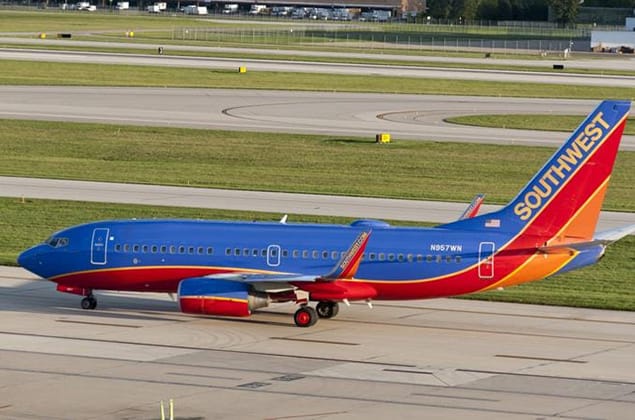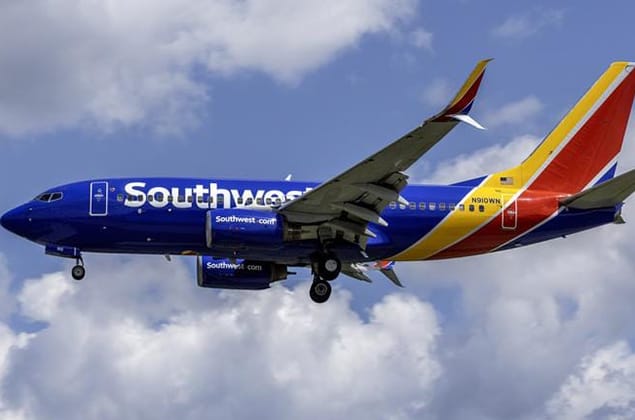Boeing 737-700 Specifications & Booking
Overview of the Boeing 737-700
The Boeing 737-700 is a narrow-body, twin-engine jet airliner manufactured by Boeing Commercial Airplanes. As a commercial aircraft, its primary purpose is to transport passengers and cargo. The first flight of the 737-700 took place on February 15, 1993, and it received Federal Aviation Administration (FAA) certification in April 1998.
Technical Specifications
The Boeing 737-700 has the following technical specifications:
- Dimensions: Length: 102 feet 7 inches (31.3 meters), Wingspan: 93 feet 5 inches (28.5 meters), Height: 24 feet 6 inches (7.5 meters)
- Weight: Empty Weight: 64,000 pounds (29,000 kg), Maximum Takeoff Weight: 174,000 pounds (79,000 kg)
- Engines: Two CFM International CFM56-7B turbofans, each producing 12,000 pounds-force (53 kN) of thrust and with a fuel efficiency rating of approximately 4,500 pounds-hours per pound (20.5 MJ/kg)
- Performance: Maximum Speed: Mach 0.79 (around 530 mph or 853 km/h), Range: Up to 3,900 nautical miles (7,223 kilometers) with a maximum payload, Cruising Altitude: typically between 24,000 and 41,000 feet (7,300 to 12,500 meters)
- Capacity: Passengers: Typically up to 149 passengers in a two-class configuration, Cargo: Up to 10,800 pounds (4,900 kg) of cargo or 1,100 cubic feet (31 cubic meters) of cargo volume
Design and Features
The Boeing 737-700 boasts innovative design elements and features, including its distinctive raked wingtips, improved aerodynamics, and advanced avionics. Its unique design earned it the 1995 Society of Automotive Engineers (SAE) Aerospace Engineering Magazine's "Design of the Year" award.
History and Development
The Boeing 737-700 was developed as a response to growing demand for efficient, reliable, and cost-effective narrow-body aircraft. Key milestones include:
- First flight: February 15, 1993
- Certification: April 1998
- Entry into service: November 1998 with Southwest Airlines
- Significant upgrades or variants:
- 737-700ER (Extended Range) variant, which extended the aircraft's range by up to 3,000 nautical miles (5,556 kilometers)
Operational Use
The Boeing 737-700 is widely used in commercial aviation. Airlines such as Southwest Airlines, Delta Air Lines, and Ryanair operate the aircraft on a variety of routes, from short-haul domestic flights to longer international journeys.
Interesting Facts
Here are some interesting or lesser-known facts about the Boeing 737-700:
- The 737-700 was one of the first commercial aircraft to feature a "glass cockpit" with digital instruments and displays.
- In 2005, a modified 737-700 set a record for the longest non-stop flight by a commercial airliner, flying from Hong Kong to Honolulu, Hawaii, in just over 14 hours.
- The 737-700 has appeared in popular culture, such as in the TV show "The West Wing" and the movie "Catch Me If You Can."
Frequently Asked Questions
What makes the Boeing 737-700 unique?
The 737-700's unique features include its advanced aerodynamics, improved fuel efficiency, and modern avionics. Its raked wingtips also contribute to its distinctive appearance.
How much does the Boeing 737-700 cost?
The estimated cost range for a new Boeing 737-700 is between $50 million and $70 million, depending on the configuration and customization chosen by the airline or operator. Used aircraft prices vary widely depending on factors such as age, condition, and previous usage.
What is the range of the Boeing 737-700?
The maximum range of a standard 737-700 is around 3,900 nautical miles (7,223 kilometers), but with the -700ER variant, this can be extended to over 6,000 nautical miles (11,110 kilometers). Compare this to similar models like the Airbus A320, which has a maximum range of approximately 3,300 nautical miles (6,112 kilometers).
Which airlines operate the Boeing 737-700?
Airlines such as Southwest Airlines, Delta Air Lines, Ryanair, and many others operate the Boeing 737-700. They choose this aircraft for its reliability, efficiency, and versatility.
Is the Boeing 737-700 still in production?
The Boeing 737-700 is no longer in production, as Boeing has shifted focus to the newer Next Generation (NG) models, including the 737 MAX. However, many existing 737-700 aircraft continue to be used by airlines around the world.





